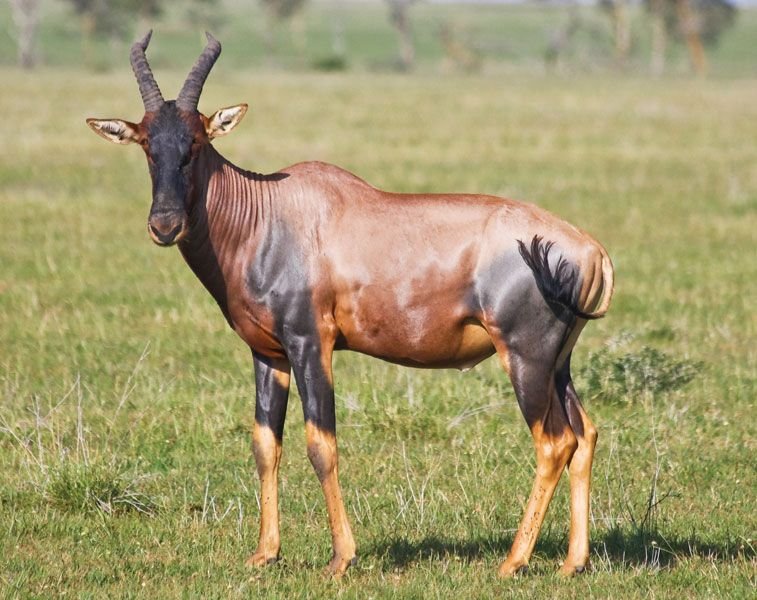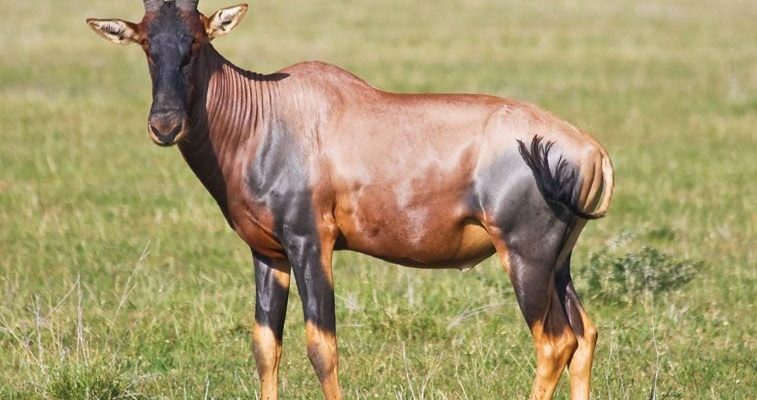
Exploring these animals not only helps you appreciate the diversity of wildlife but also enhances your understanding of how to distinguish between them. Think of it like recognizing different types of birds by their colors and songs. It’s all about noticing the little details. So, grab a cup of coffee, and let’s dive into the world of antelopes and their look-alikes!
What is a Topi?
Before we jump into comparisons, let’s take a moment to understand what a topi is. Found mainly in eastern and southern Africa, the topi is a member of the antelope family. Its coat is reddish-brown, with distinctive dark patches on its face and limbs. They are known for their impressive speed, which helps them evade predators like lions and hyenas.
Topis are social animals, often seen in small herds. They have a fascinating behavior of standing on high ground to survey their surroundings—a bit like a lookout, ensuring their safety. This unique characteristic makes them stand out in the savanna. In this section, let’s set the stage and explore some fascinating animals that share the same habitat and have features that might remind you of the topi.
1. Hartebeest
The hartebeest is a robust antelope that can easily be mistaken for a topi. With a similar body shape and long legs, they thrive in open grasslands. However, there are some key differences to help you tell them apart. Hartebeests have a more elongated face and distinctive curved horns that are not as sharp as those of a topi.
Their coloring varies from tan to reddish-brown, but they often have a lighter patch on their face, which the topi lacks. If you see a hartebeest standing still, you might notice its unique posture, often with the head held high, unlike the more relaxed stance of a topi. So next time you’re out in the wild, look closely at the horns and facial structure—these are your best clues!
Physical Differences
- Horns: Hartebeests have broader, more curved horns.
- Face Shape: Hartbeest faces are longer and more tapered.
- Body Size: Hartebeests tend to be slightly bulkier than topis.
2. Bosman’s Antelope
Meet the Bosman’s antelope, a lesser-known relative of the topi. This antelope is about the same size, but distinguishing features make it unique. The Bosman’s antelope has a richer, darker coloration with prominent white markings on its face and legs.
You might spot them in the same regions where topis roam, often in mixed herds. Although they share the savanna, Bosman’s antelopes are less commonly seen. Their shy nature means they often blend into their environment, using their color to their advantage. Look for the white patches—this is your best identifier when trying to distinguish them from topis.
Behavioral Traits
- Social Structure: Bosman’s antelope often stay in smaller groups.
- Coloration: Their dark color helps them blend in with their surroundings.
- Habitat: Prefer slightly bushier areas compared to open savanna.
3. Waterbuck
Another contender is the waterbuck, an antelope that loves wet areas. While both waterbucks and topis have a similar build, waterbucks can easily be identified by their shaggy coats. Their fur is typically a grayish-brown color with a distinct white ring around the nose, making them stand out.
Waterbucks are larger than topis and have a dense build. They also have long, straight horns that can curve a bit at the end, very different from the topi’s shorter, thicker horns. You’ll often find them near lakes or rivers, where they graze on grass. If you spot a group of antelopes near water, look for the unique coat and white markings—that’s your waterbuck!
Living Conditions
- Habitat Preference: Waterbucks prefer wetlands and riverbanks.
- Color and Texture: Their shaggy fur distinguishes them from topis.
- Group Behavior: Often found near water sources in larger herds.
4. Tsessebe
The tsessebe is another strong contender, often confused with the topi due to their similar sizes and shapes. However, the tsessebe is known for its impressive speed and has a more elongated face. Their coat is usually a deep chocolate brown, with darker patches and a unique, sleek appearance.
One of the easiest ways to tell a tsessebe apart is by observing its speed. They are incredibly fast, known to be one of the fastest antelopes in Africa. Also, if you look closely at their legs, you’ll notice they’re more slender compared to those of a topi.
Key Identifiers
- Body Structure: Tsessebe have longer legs and a more streamlined body.
- Speed: Known for their quick sprinting ability.
- Facial Features: Longer face and sharper features compared to topis.
5. Impala
Last on our list of similar antelopes is the impala. While they are generally smaller than topis, their agile bodies and graceful movements can easily draw comparisons. Impalas have a reddish-brown coat with white underbellies and are known for their impressive leaping abilities.
You might be wondering how to spot one among a herd of topis. A big giveaway is their size; impalas are much lighter and more slender. Their facial markings are also different, featuring more pronounced white markings around their eyes. If you see a group darting away with incredible jumps, chances are you’re watching the agile impala in action!
Distinct Characteristics
- Size: Impalas are smaller and lighter than topis.
- Jumping Ability: Known for their incredible leaps.
- Color Patterns: More distinct white markings on their face and body.
6. Wildebeest
The wildebeest, or gnu, is a large antelope renowned for its distinct appearance. Although they don’t closely resemble topis in color, their overall body structure can appear similar from a distance. Wildebeests have a bulky build, with large heads and curved horns that can be quite striking.
Their coat is typically a bluish-gray, which can make them an interesting contrast to the reddish-brown topis. Look for their thick manes and beards, which are quite different from the smooth coat of a topi. Plus, wildebeests are often found in much larger herds, especially during migration, making them easy to spot in a crowd.
Physical Features
- Body Structure: Wildebeests have a heavier, more robust build.
- Coat Color: Typically bluish-gray, contrasting with the topi.
- Herd Behavior: Usually found in large migratory groups.
7. Grant’s Gazelle
The Grant’s gazelle is yet another look-alike that you might encounter in the savanna. These gazelles are slightly smaller than topis, with graceful bodies and long, slender legs. Their coats are a light tan color with striking black stripes that run down their sides.
To differentiate Grant’s gazelles from topis, watch their movements. While topis are more robust, Grant’s gazelles are much more elegant in their gallops. Additionally, their smaller, curved horns and softer facial features can help you identify them easily.
Identification Tips
- Size: Grant’s gazelles are smaller and lighter than topis.
- Coloration: Look for the black stripes on their sides.
- Movement: More graceful, with a lighter, more elegant gallop.
8. Sable Antelope
The sable antelope is often revered for its striking appearance and impressive horns. While they have a similar body type to the topi, sable antelopes stand out with their dark brown to black coats and long, curved horns that can reach impressive lengths.
Sables tend to be more solitary or found in small groups compared to the social structure of topis. If you see a sable, it’ll likely be grazing peacefully, showcasing its beautiful color contrast against the green grass. The difference in coat color is the easiest way to distinguish a sable from a topi.
Unique Features
- Horns: Sables have much longer, curved horns.
- Coloration: Darker coat compared to the reddish-brown topi.
- Habitat Behavior: Often found alone or in small groups.
There you have it! Eight remarkable animals that share similarities with the topi but carry their unique traits. Whether it’s the graceful movements of the Grant’s gazelle or the striking appearance of the sable antelope, each of these animals adds to the rich tapestry of wildlife in Africa. Understanding these differences not only enhances your wildlife-watching experience but also deepens your appreciation for nature.
So, next time you find yourself in the savanna or watching a wildlife documentary, see if you can spot these characteristics. It’s like playing a fun game of “I Spy” with nature! Keep an eye out, and enjoy the beauty and diversity of these amazing animals!

